Essential Jazz Listening: Louis Bellson

“As the esteemed composer and arranger Robert Farnon writes in the liner notes: ‘As the collection of Louis Bellson’s recorded performances increases, so do the limitless talents of this complete musician. In addition to his drumming artistry, he has proven to be equally at home in the Composing and Arranging World, as this gem of an album clearly Illustrates. Congratulations Lou!’ Tony Bennett, who was in the booth for the recording added, ‘This album is too much: it’s a masterpiece. It gave me great pleasure to be present in the control room whilst it was being recorded.’ Bellson: a brilliant player according to all concerned.”—Dean Pratt
Vinyl Tap
By Dean Pratt
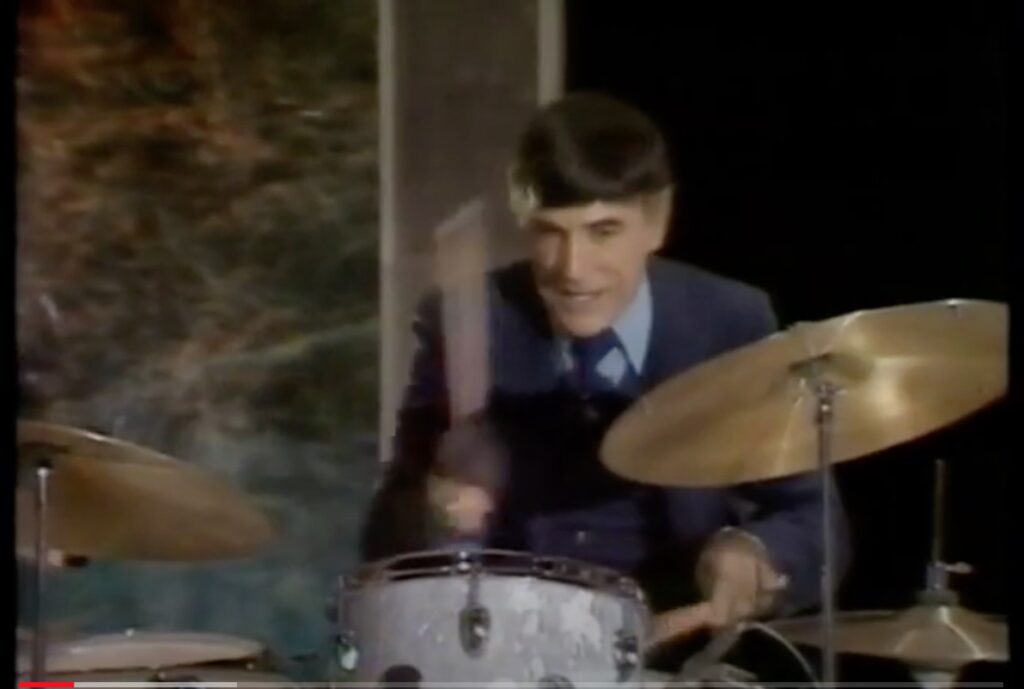

“To listen and see Louie is to know ‘Man’s love of music.’”—Pearl Bailey Bellson
“Not only is Louie Bellson the world’s greatest drummer . . . he is the world’s greatest musician!”—Edward Kennedy “Duke” Ellington
Author’s Note: My friend Audrey Mannes Mosello put this (vinyl) ball in motion when she asked me to post my favorite albums—my “essential jazz listening list”—on Facebook over a specified-by-her period of time. Or something like that. Audrey, you know what you asked of me, but I doubt you expected the deluge that would follow on as a result of your innocent request.
PENDLETON South Carolina & MANHATTAN New York—(Hubris)—1 July 2023—Luigi Paulino Alfredo Francesco Antonio Balassoni or, as he was known to us in the world of music, Louis Bellson.
As a young musician, and fan of the big band era and the great bands of that time, I realized at an early age how not only important the musician in the drum chair was, but how much each band’s excitement, swing, and success depended on that one particular musician.
All band leaders are aware that no matter how many terrific musicians are seated in the horn sections of your ensemble, if your drummer is not making it, your band is not making it. Hence, when a drummer proved his ability to demonstrate an exceptional beat, feel, sense of swing, along with a dynamic technique, that drummer would be at the top of a bandleader’s list for hire.
For me, in those early years, and still today, the big three drummers I searched the record bins for were Gene Krupa, Buddy Rich and Louis Bellson. Upon winning the Slingerland National Gene Krupa drum contest (in which over 40,000 contestants competed) at age 17, Louis Bellson’s career was well on its way. He would soon become one of the big band era’s most important drummers, holding down that essential chair with Benny Goodman, Tommy Dorsey, Harry James, Duke Ellington, Count Basie and, eventually, as leader of his own swinging ensembles.
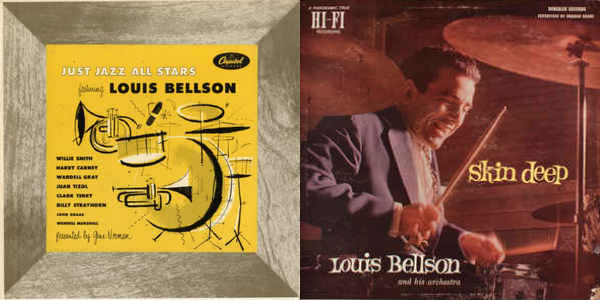
In February of 1952, while a member of Duke Ellington’s orchestra, Bellson recorded his first date as a leader, Capitol Records’ “Louis Bellson Just Jazz All Stars,” the band—largely comprising his colleagues from the Ellington band: Clark Terry, Juan Tizol, Willie Smith, Harry Carney, Billy Strayhorn, Wendell Marshall, John Graas (frn) and Wardell Gray (tenor) —performing compositions and arrangements by Louis Bellson/Buddy Baker (“Eyes,” “Shadow”), Juan Tizol (“Rainbow”), Shorty Rogers (“Sticks,” “Punkin”), Billy Strayhorn (“Johnny Come Lately,” “Passion Flower,” “The Jeep Is Jumpin”). Produced by Just Jazz impresario Gene Norman, this is a really nice set of octet jazz.
Recorded in 1954 in New York City (small band) and in 1955 in Hollywood (big band) for Norman Granz’s Norgran Label, “Skin Deep” is the title of a Bellson composition and arrangement he had previously recorded with the Ellington band. This solo, along with his tenure on the band, marked Bellson’s explosive rise as one of the premier drummers of the music. The personnel on the big band sides comprise Conrad Gozzo, Ray Linn, Harry Edison and Maynard Ferguson (tpts), Herbie Harper, Tommy Pederson and Hoyt Bohannon (tbs), Benny Carter, Willie Smith, Wardell Gray, Bumps Meyers and Bob Lawson (reeds), Jimmy Rowles (piano), Barney Kessel (guitar), and John Simmons (bass). The small band sides have Don Elliott (mellophone, vibes, trumpet, bongo drums), Joe Puma (guitar), Bob Peterson (bass), and Ralph Martin (piano).
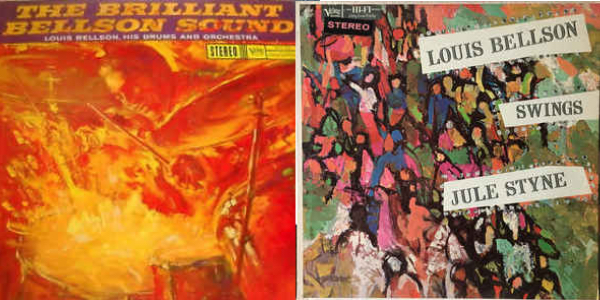
“The Brilliant Bellson Sound,” recorded for Verve in 1959, is an interesting big band date: Johnny Audino, Guido Basso (solos), Ralph Clarke, Fred Thompson (tpts), Nick Di Maio, Earl Swope (solo), Juan Tizol (tbns), Herb Geller (solo), Nick Nichols, Aaron Sachs (solo), George Perry, Oliver Nelson (reeds), Joe DeAngelis (frn), Eddie Diamond (piano/solo), Charles Parham (bass), Laurence Lucie, Tony Rizzi (guitar), and Jack Arnold (Boo Bams/Vibes). Arrangements by Bob Florence, Ernie Wilkins, Marty Paich, Aaron Sachs and Bellson.
Another favorite Verve LP of mine is “Louis Bellson Swings Julie Styne.” Recorded in February of 1960, Bellson here gives a lesson in big band drumming on a set of Mr. Styne’s most popular compositions. Unfortunately, no arranger credits are given but, if I had to guess, I would nominate Bob Florence for most of the scores.
My all-time favorite Bellson big band LP is “Big Band Jazz From The Summit,” recorded live at the club in 1962 by the master engineer of location recordings, Wally Heider. Made for Roulette Records, this is big band jazz at its best. An all-star group of LA’s top musicians are here: Al Porcino, Ray Triscari, Conte Candoli, John Audino, Frank Huggins, Jimmy Zito (tpts), Nick Di Maio, Mike Barone, Frank Rosolino, Ernie Tack (tbns), Red Callender (tuba), Joe Maini, Bill Green, Bill Perkins, Carlington Visor, Teddy Lee (reeds), Gene Estes (Boo Bams/Vibes) Tony Rizzi (guitar), Lou Levy (piano), and Jimmy Bond (bass). Charts are by Benny Carter, Marty Paich, Shorty Rogers, George Williams, and Bob Florence. Highlights are solos by Candoli, Maini, Zito, Perkins, Levy, and Bellson. Get it!
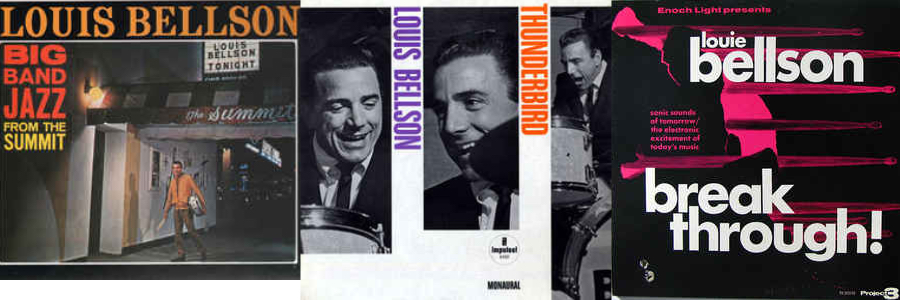
For a month in 1963, Bellson took a small group into the Thunderbird Hotel in Las Vegas. Louis writes in the notes, “We worked the graveyard shift from midnight to six in the morning. All the show people used to come in to listen, and we liked that.” If you listen to this album, you will like it as well: This is one terrific album. Personnel: Harry Sweets Edison (tpt), Carl Fontana (tbn), Sam Most (alto), Ed Scarazzo (tenor), Jim Mulidore (bari), Arnold Teich (piano), Jim Cook (bass), and Bellson (drums). Arrangements are by Marty Paich (“Cottontail”), Neal Hefti (“Softly With Feeling”), Thad Jones (“The Little Pixie”), Jay Hill (“Serenade In Blues”), Bill Perkins (“Nails”), Kenny Sampson (“Back On The Scene”), Bellson/Fred Thompson (“Thunderbird”), and Lalo Schifrin (“No More Blues”). Every tune has something to offer on this beautifully recorded LP, and the sound of the drums is outstanding. Highlights are solos by Sweets, Fontana, and the leader. This should be in everyone’s collection.
In 1967, Bellson was getting calls to bring a band into Dante’s and other clubs in the LA area but, as he said, “I didn’t want to do it until I had worked out something new and exciting. Thanks to the wonderful group of musicians I was able to put together, and the fine work by the arrangers, I think we accomplished what I set out to do.” Louis worked around LA with his new band until the spring of 1968 when he was engaged by the Riverboat Room at the Empire State Building in New York for a two-week stint.
Enoch Light, producer for Project 3 Records, had been talking to Louis about recording the band and the Riverboat gig, where Project 3 was based, and brought their conversations to fruition. His key men from LA were on board: Nick Di Maio, Benny Powell, Jimmy Cleveland, Bill Tole (tbns), Pete Christlieb, Sam Most (reeds), Ross Thompkins (piano), Paul Ubinon (lead trumpet), Jack Arnold (vibes), and, rounding out the band from New York, Marky Markowitz, Jim Bossey, Marvin Stamm (tpts), Pat Rebillot (piano), Tony Mottola, Barry Galbraith (guitar), George Duvivier (bass), and Doug Allen (percussion). Arrangements are by Marty Paich, George Roumanis, Bill Holman, Jack Arnold and Mike Barone. Highlights are solos by Pete Christlieb (check him out on Holman’s arrangement of Leonard Feather’s “I Remember Bird”), Marvin Stamm, Sam Most and the leader.
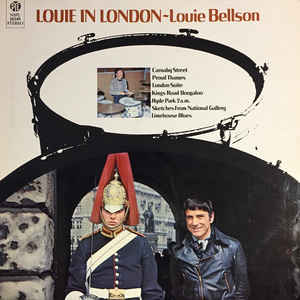
Though I haven’t written much about Mr. Bellson’s composing and arranging abilities, they are immense, and most of his recordings feature at least one of his own scores.
The 1970 English PYE LP, “Louie in London,” illustrates just what a consummate musician Louis Bellson was. The LP, except for one track, the Derek Cox arrangement of “Limehouse Blues,” was written and arranged by Bellson in collaboration with Jack Hayes. It’s a stunning example of the composing and drumming of the master Louie Bellson. Britain’s top musicians were gathered together by trumpeter/contractor Stan Reynolds: Reynolds, Greg Bowen, Stan Roderick, Pete Winslow, Kenny Wheeler, Eddie Blair (tpts), Don Lusher, Harry Roche, Wally Smith, Bobby Lamb, Bill Geldard (tbns), Roy Wilcox, Dennis Walton, Bob Efford, Brian Ashe, Bernie George, Peter Hughes (reeds), Frank Horrax (piano), Arthur Watts (bass), Ernie Shear (guitar), and Derek Warne (percussion).
As the esteemed composer and arranger Robert Farnon writes in the liner notes: “As the collection of Louis Bellson’s recorded performances increases, so do the limitless talents of this complete musician. In addition to his drumming artistry, he has proven to be equally at home in the Composing and Arranging World, as this gem of an album clearly Illustrates. Congratulations Lou!”
Tony Bennett, who was in the booth for the recording added, “This album is too much: it’s a masterpiece. It gave me great pleasure to be present in the control room whilst it was being recorded.”
Bellson: a brilliant player according to all concerned, especially the leader.
All essential listening!
![]()
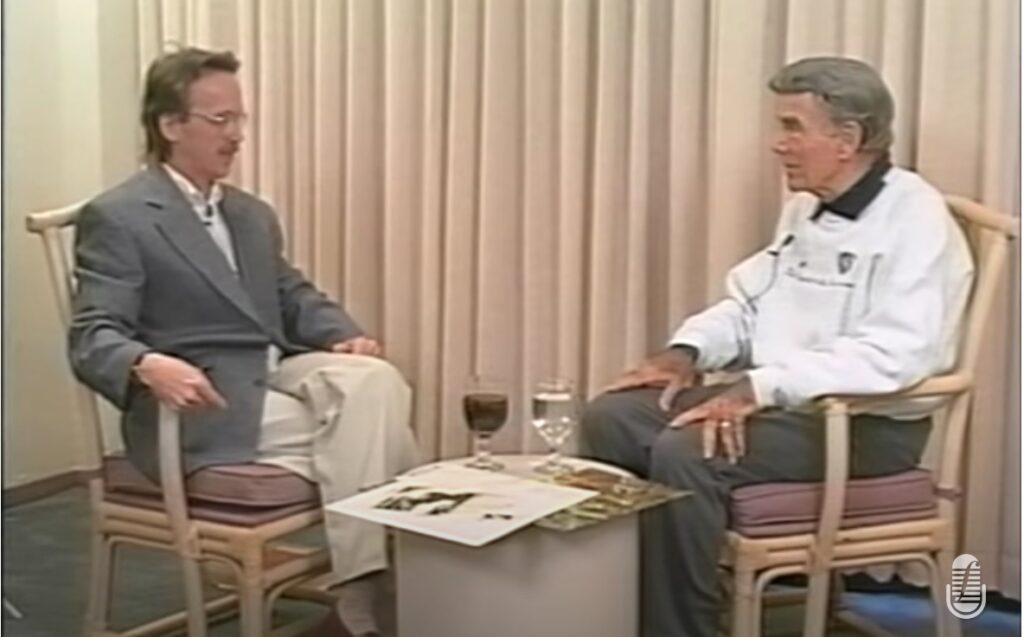
![]()